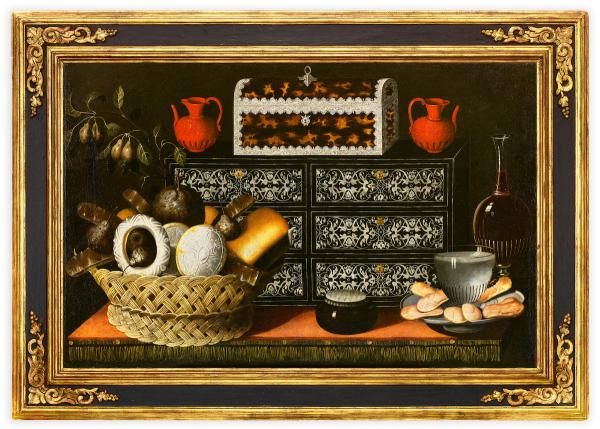Featuring a basket of delicately glazed buns, a gleaming silver and tortoiseshell chest, and an intricately decorated ebony and ivory box, among other enticing edibles and consumables, this still life painting showcases luxury objects found in wealthy homes across Southern Europe in the 17th century. Through the items shown here and the rare and costly materials needed to make them, Bernardo Polo directly foregrounds Asian, African, and American trade and labor to, through, and from, Spain.
The multi-drawered cabinet is perhaps Flemish or Italian in origin, and yet its precisely inlaid ivory and ebony were extracted from Asia and Africa. The chest that sits atop it, made from highly valued silver and tortoiseshell, is Indo-Portuguese, likely made in Goa. The small red clay pots, or búcaros, were vessels made in Portugal as well as Mexico. Collected for their aroma and the flavor they infused in the water stored within them, they were prized by wealthy women in Spain and Italy in the 17th and 18th centuries who often took small bites of the clay for its supposed curative properties.
While many of these materials were prized for their rarity, the most consequential commodity of the 17th century, sugar, is also on display. Mixed into an infusion in the striated cup and shown on the glazed pastries, sugar was the primary export from the Americas after European powers established its production as a main industry of the Caribbean, spanning from the gulf region of North America to the northeast of South America. Along with silver, which was mined in enormous quantities by the Spanish in both Peru and Mexico, sugar fueled the trade across the Atlantic and Pacific that included not just materials extracted from colonized lands, but enslaved people. All of the rare, natural materials on exhibit here were gathered by unidentified laborers across three continents. The artisans who assembled these exported objects also remain unnamed.
Among the group of paintings attributed to Bernardo Polo, this is one of the finest, and most remain in private hands in Spain. The painting joins several 17th-century Dutch still lifes in the museum’s collection, some of which also feature luxury objects that arrived in the Netherlands via global trade routes, as well as a small selection of French and Italian examples from the 17th and 18th century. However, it is the first Spanish still life painted before the 20th century to enter the museum’s collection. Still Life with an Ebony and Ivory Cabinet, Tortoiseshell Chest, and Sweets is also an important addition to our collection of 16th- to 18th-century Spanish painting and sculpture, which we have focused on growing in recent years. Beyond its natural connections to works of European art in the collection, its subject establishes significant dialogues with material in multiple departments across LACMA’s collection, including Colonial Latin American Art and the art of South and Southeast Asia.
During our 37th annual Collectors Committee Weekend (April 21–22, 2023), members of LACMA's Collectors Committee generously helped the museum acquire 10 works of art spanning a breadth of eras and cultures. We'll be sharing information about these acquisitions throughout the week here on Unframed.



